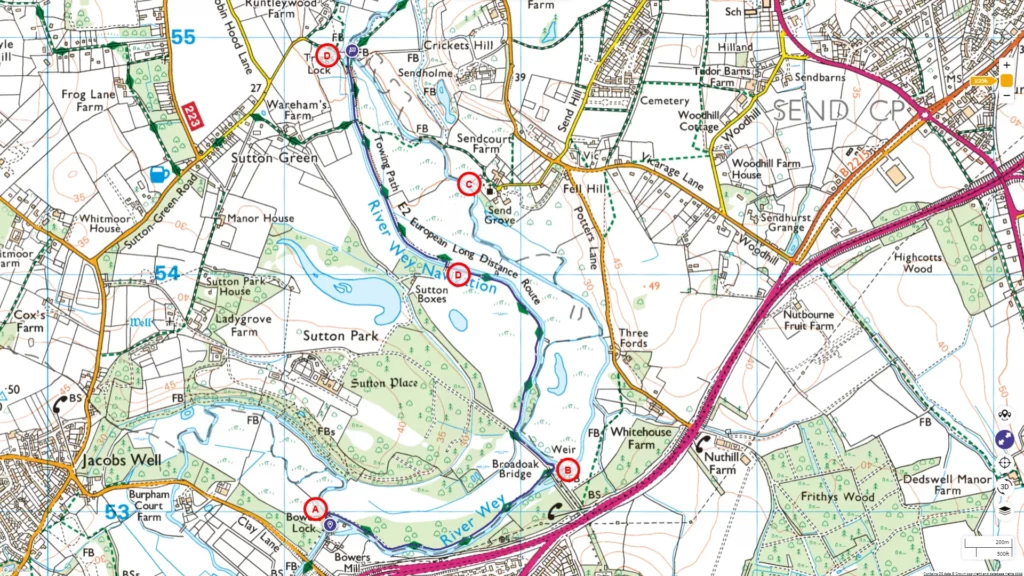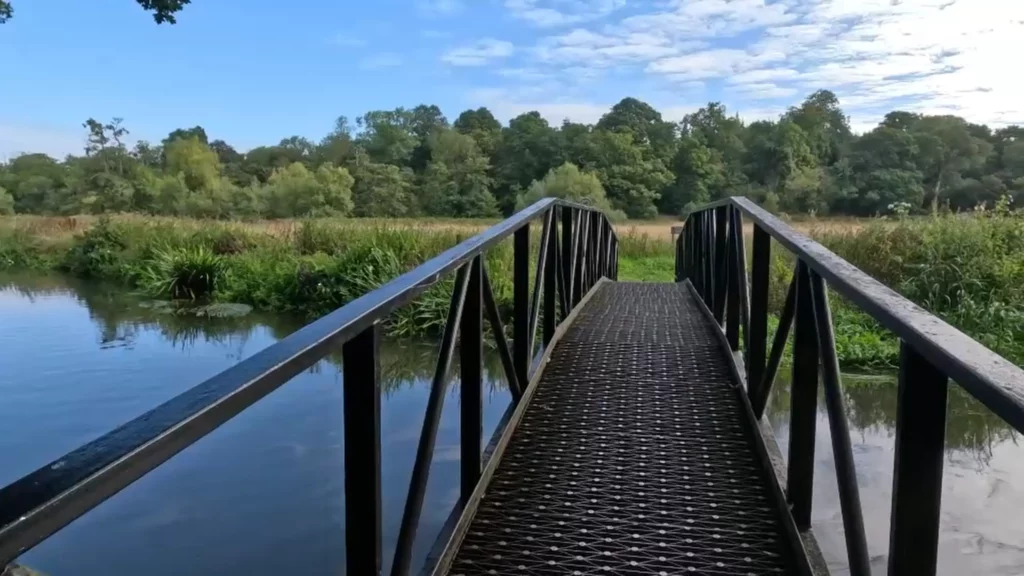Embark on a serene morning stroll to witness the arrival of wild geese preparing for winter near Sutton Place and observe the intricacies of canal boats navigating upstream at Triggs Lock.
Follow the entire walk on . The route map is available on
.

A: Bowers Lock
B: Sutton Place and Broadoak Bridge
C: St. Mary’s Church at Send
D: Triggs Lock
Our journey continues from where our previous video left off at Bowers Lock [A]. We then proceed to cross the metal footbridge to the opposite side of the left bank of the towpath. At approximately 16:45 minutes into the video, you can delight in the sight of a flock of wild geese honking their way in for the winter from their breeding grounds in Arctic Russia.
As we pass under the Broadoak Bridge, connecting to the A3 (with audible rumbling traffic), which leads to Sutton Place [B], let’s take a moment to learn about this historical location. Sutton Place is a grand Grade I listed Tudor prodigy house. The land that Sutton Place occupies was described in the Domesday Book of 1086 as the ‘Manor of Sudtune,’ which eventually evolved into ‘Sutton.’ Read more… This manor was once linked to the royal manor of Woking, where Edward the Confessor had intentions to construct a hunting lodge, occupying the site now home to St. Edward’s Church.
This splendid estate, built around 1525 by Sir Richard Weston, a courtier of Henry VIII, holds significance in art history for displaying some of the earliest traces of Italianate Renaissance design elements in English architecture. Wikipedia
Although the main house isn’t visible from our current vantage point along the Wey, you can spot an impressive gravel driveway on your left after passing under the bridge. The property’s security appears stringent, with signs warning of dogs patrolling the grounds. Notably, Alisher Usmanov, a Russian multi-billionaire born in Uzbekistan, faced UK government sanctions in 2022, with ties to English football clubs Arsenal and Everton, and ownership of Sutton Place estate. Financial Times
Continuing on the towpath, it straightens out after a sharp northward. In approximately one kilometre, you’ll come across a footbridge that will take you back to the other bank. During this time of year, the lush foliage of trees may partially obscure the view of the medieval St. Mary’s Church [C] across the water meadows at Send Grove to your right. However, you might catch a glimpse of the church from another footbridge located about half a kilometre downstream.
St. Mary’s Church enjoys an enchanting location, almost inviting you to envision it veiled in an ancient, mystical mist drifting in from the river. The church’s history traces back to its mention again in the Domesday Book. Read more… However, the existing tower, nave, and chancel underwent reconstruction around the year 1200. In the 18th century, seemingly driven by a competitive spirit, the tower’s height was increased by adding nine additional courses of bricks. Within the churchyard, lies the final resting place of Walter Grove, one of the master carpenters who played a crucial role in the construction of the Navigation. He rests there alongside his wife and three children, a testament to the enduring legacy of those who contributed to this historic waterway.
As you approach Triggs Lock [D], you’ll notice more long boats moored along the left bank. Triggs Lock, with a substantial rise of 1.98 meters, was first commissioned in 1653. It holds a unique distinction as the halfway point along the Navigations to the Thames, with Weybridge located 15 kilometres downstream. Over the years, the lock’s original timber and turf sides underwent several stages of reconstruction, eventually giving way to a more durable concrete structure.
The lock-keeper’s cottage, standing nearby, dates back to 1769, with an extension added in 1916. In 1987, the National Trust undertook a renovation, preserving its unique isolation, which has attracted artists and photographers alike.
One notable figure associated with Triggs Lock was William Grove, a dedicated member of the Navigation community. He lived here until the remarkable age of 90. Beginning in 1856, he served as the lock-keeper and, in addition to his duties, he also worked as a blacksmith after completing an apprenticeship. Behind the cottage, he established a forge where he both crafted and repaired much of the Navigation’s ironwork.
Originally, the water management system required the keeper to manually adjust paddles in the lock gates to control the flow of surplus water. However, this cumbersome arrangement was later replaced by the Trust with a more efficient tumbling bay, relieving the keeper of constant oversight as it offered a self-regulating control mechanism. Located just downstream, opposite the towpath, was a wharf primarily used for loading and unloading purposes; it did not include a warehouse.
For those seeking refreshment, The Olive Tree, the closest pub to Triggs Lock, is just a short stroll upstream and accessible via Warehams footbridge.
We invite you to join us in the upcoming episode of this video series, where we will continue our journey from Triggs Lock to Papercourt.

